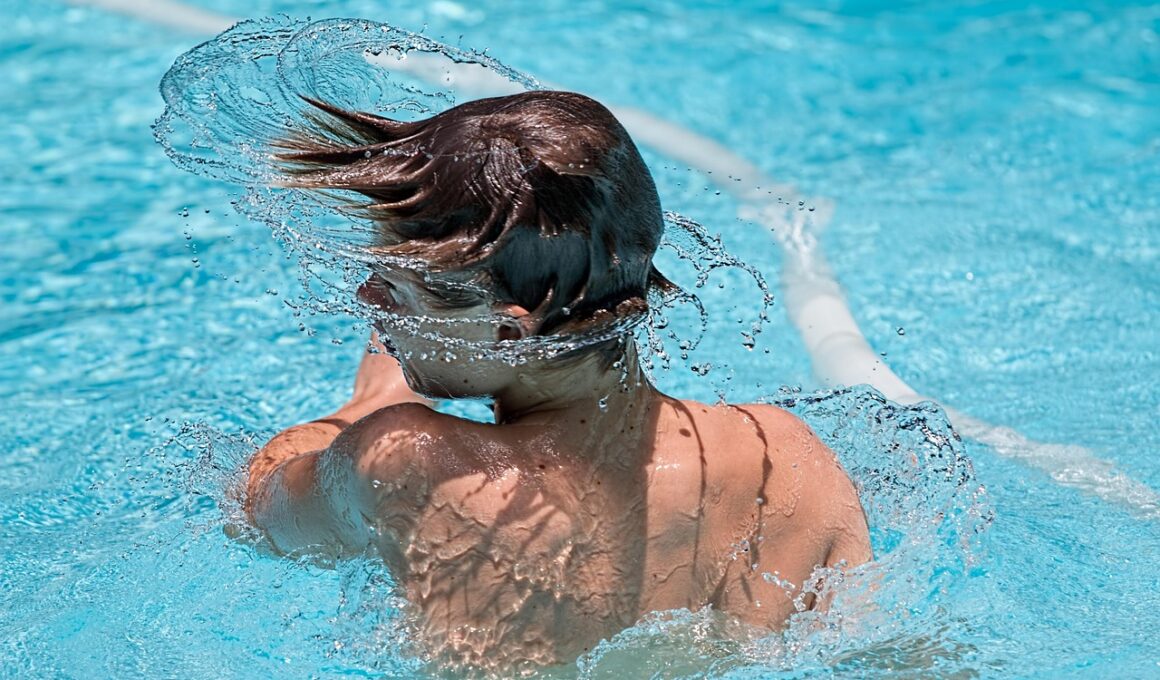Troubleshooting Common Swimming Pool Issues
Maintaining a swimming pool can be challenging, especially when unexpected issues arise. One of the most common problems pool owners face is water clarity. If your water appears cloudy or murky, it might be due to poor filtration, inadequate chemical balance, or even debris accumulation. Regularly check the pool’s filtration system to ensure optimal operation and cleanliness. The recommended water chemical levels for pH, chlorine, and alkalinity should be maintained. You can aim for pH levels between 7.2 and 7.8, ensuring your pool is safe for swimming. Checking the skimmer basket and the main filter and backwashing the system can help as well. Additionally, consider vacuuming your pool to remove any settled debris. Using algaecides can also prevent algae growth, which often contributes to cloudy water. When in doubt, consult a local pool expert or your service provider for personalized guidance to keep your pool inviting and clear. Document your maintenance routine for reference, helping you identify patterns, which may simplify troubleshooting down the line.
Another common issue you might experience is pool water that is too warm, especially during summer months. High water temperatures can lead to increased chemical consumption and uncomfortable swimming conditions. Many pool owners find relief using pool covers during the day to reduce heat gain. Installing a solar cover not only maintains temperature but also keeps debris out. Additionally, consider planting trees or installing shade structures around your pool. Always monitor the water temperature with a reliable thermometer, ensuring it remains at comfortable levels throughout the season. Be careful of excessive evaporation during hotter days; replenishing your pool with fresh water can help maintain chemical balance and temperature. Regularly inspecting your pool’s pump and heating systems will help you identify any malfunctions early, ensuring smooth functioning. Moreover, a functioning pool heater can maintain warmth during cooler nights. If you notice persistent heating problems, it may be wise to consult a professional who specializes in pool heater maintenance and repairs. Keeping a pool log can help track temperatures and record maintenance for optimal health.
Dealing with Pool Equipment Failures
Moreover, pool equipment failures can be frustrating and often arise unexpectedly. Issues with the pump, filter, or heater can disrupt your pool enjoyment and require urgent attention. Begin troubleshooting by ensuring that all electrical connections are secure but powered off to avoid accidents. Look for visible signs of wear or leaks in the pump or heater components. A clogged filter can cause ineffective circulation and low water pressure. Cleaning or replacing pool filter cartridges is generally a straightforward process but should be done regularly to maintain system efficiency. Additionally, consider the intervals between checks and ensure you service your pool equipment as recommended by the manufacturer, which can vary by model. Listening carefully for unusual noises while equipment operates can alert you to potential mechanical failures. Monitoring the pressure gauge on your filter is crucial; if the pressure is consistently too high or low, there may be issues that require immediate fixing. This proactive approach will prevent significant damages, costly repairs, or halted circulation, ensuring your pool remains in ideal condition for swim enthusiasts.
Another frequent issue to be aware of is the emergence of algae in your swimming pool. Algae growth can turn your beautiful blue pool into an unsightly green mess. To combat algae, maintaining appropriate chlorine levels is critical. Regular shock treatments are essential, particularly after heavy rains or storms, which can disturb chemical balances. When cleaning, scrub the walls and steps with a pool brush to dislodge any stubborn algae. Afterward, use the pool vacuum to remove dead algae and debris. Applying algaecides can also further enhance your pool’s defenses against these unwanted guests. If you have persistent algae problems, consider performing a thorough cleaning and examining the filter for efficiency, as a malfunctioning system may be the root cause. Additionally, ensure your pool’s water is circulating correctly—poor circulation promotes algae growth. Rinsing off pool equipment before use and limiting the number of contaminants added to the water can also aid in preventing algae from reestablishing itself. If the problem continues or spirals out of control, seeking a professional treatment can often be valuable.
Addressing Leaks in Your Pool
Pool leaks are a common concern that can contribute to rising water bills and impact your pool’s health. Identifying a leak early is essential for mitigating damage and addressing the underlying issue. A simple water level test is effective: mark your water level, then wait for 24 hours. If the water has dropped significantly, you may have a leak. Inspect the skimmer, returns, and plumbing lines for visible leaks. Pay particular attention to lights, equipment fittings, or any visible cracks in the pool’s shell. For in-ground pools, consider checking around the liner and examining gate entries for signs of failure. Some leaks can be repaired using specific sealants, while others might require professional intervention. If you suspect the leak is in the plumbing, it might be wise to hire a leak detection service who specializes in locating and fixing such problems. By gaining an understanding of your pool’s water level behaviors, you will be better equipped to determine when issues arise, ensuring a consistently enjoyable swimming experience.
Cloudy water often requires immediate action and can stem from various causes, including chemical imbalances or issues with the filtration system. Routine testing of your pool water may help you avoid cloudy situations altogether. After determining the problem, treat accordingly by adding the necessary pool chemicals to balance the water chemistry, ensuring proper levels of pH, alkalinity, and chlorine. Additionally, running the filter system longer than normal will help to clear up the water. Make sure the pool filter is clean, and check for any debris blocking the skimmers and returns, which can hinder effective water circulation. Brushing the pool walls and flooring helps prevent algae build-up that can lead to murky swimming conditions. If you frequently laugh at your cloudy water issue, consider doing a pool shock treatment and observing its effects on clarity. Using a clarifier can also promote clarity by clumping tiny particles together, making them easier for filters to remove. In persistent cases, consulting a pool maintenance professional could save you time and provide expert solutions to restore clarity.
Conclusion and Maintenance Best Practices
Conclusively, maintaining a swimming pool involves various challenges, yet understanding how to troubleshoot common issues greatly contributes to an enjoyable swimming experience. Regular inspections of your pool equipment, paying attention to water quality, and staying ahead of potential problems save you time, effort, and finances. To create a routine, develop a checklist addressing key areas to inspect, such as chemical levels, filtration systems, and physical condition. It is important to monitor your pool temperature, balancing heating elements against your preferences and wider environmental impacts. Establishing a cleaning schedule ensures both equipment upkeep and pleasant swimming conditions for friends and family. Keeping a maintenance log helps extend the life of your pool and equipment, lending insights into reoccurring problems. Engage your community for tips, and don’t hesitate to seek professional assistance when necessary. Through proactive measures, a well-maintained pool remains a centerpiece of summer fun. Don’t underestimate the value of quality service and proper care, as these efforts make swimming enjoyable and ensure safety throughout warm months.


